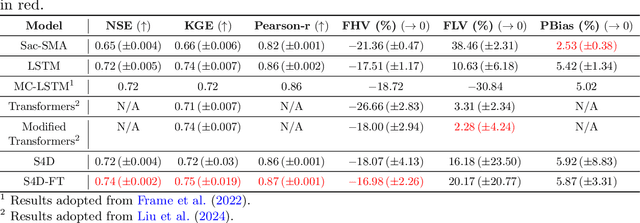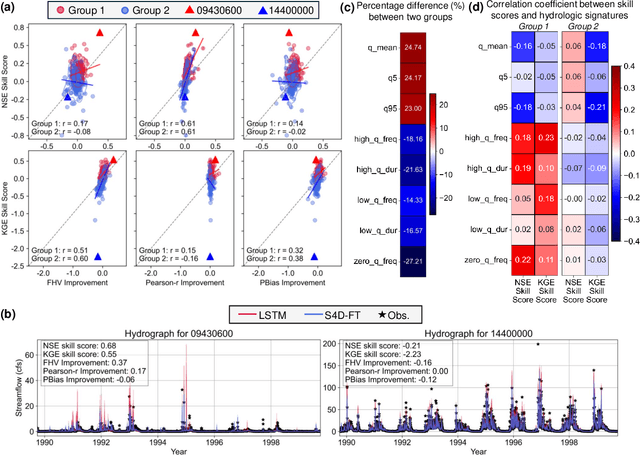Yihan Wang
Not All Samples Are Equal: Quantifying Instance-level Difficulty in Targeted Data Poisoning
Sep 08, 2025Abstract:Targeted data poisoning attacks pose an increasingly serious threat due to their ease of deployment and high success rates. These attacks aim to manipulate the prediction for a single test sample in classification models. Unlike indiscriminate attacks that aim to decrease overall test performance, targeted attacks present a unique threat to individual test instances. This threat model raises a fundamental question: what factors make certain test samples more susceptible to successful poisoning than others? We investigate how attack difficulty varies across different test instances and identify key characteristics that influence vulnerability. This paper introduces three predictive criteria for targeted data poisoning difficulty: ergodic prediction accuracy (analyzed through clean training dynamics), poison distance, and poison budget. Our experimental results demonstrate that these metrics effectively predict the varying difficulty of real-world targeted poisoning attacks across diverse scenarios, offering practitioners valuable insights for vulnerability assessment and understanding data poisoning attacks.
WAFT: Warping-Alone Field Transforms for Optical Flow
Jun 26, 2025Abstract:We introduce Warping-Alone Field Transforms (WAFT), a simple and effective method for optical flow. WAFT is similar to RAFT but replaces cost volume with high-resolution warping, achieving better accuracy with lower memory cost. This design challenges the conventional wisdom that constructing cost volumes is necessary for strong performance. WAFT is a simple and flexible meta-architecture with minimal inductive biases and reliance on custom designs. Compared with existing methods, WAFT ranks 1st on Spring and KITTI benchmarks, achieves the best zero-shot generalization on KITTI, while being up to 4.1x faster than methods with similar performance. Code and model weights are available at https://github.com/princeton-vl/WAFT.
Magistral
Jun 12, 2025Abstract:We introduce Magistral, Mistral's first reasoning model and our own scalable reinforcement learning (RL) pipeline. Instead of relying on existing implementations and RL traces distilled from prior models, we follow a ground up approach, relying solely on our own models and infrastructure. Notably, we demonstrate a stack that enabled us to explore the limits of pure RL training of LLMs, present a simple method to force the reasoning language of the model, and show that RL on text data alone maintains most of the initial checkpoint's capabilities. We find that RL on text maintains or improves multimodal understanding, instruction following and function calling. We present Magistral Medium, trained for reasoning on top of Mistral Medium 3 with RL alone, and we open-source Magistral Small (Apache 2.0) which further includes cold-start data from Magistral Medium.
Silence is Not Consensus: Disrupting Agreement Bias in Multi-Agent LLMs via Catfish Agent for Clinical Decision Making
May 27, 2025Abstract:Large language models (LLMs) have demonstrated strong potential in clinical question answering, with recent multi-agent frameworks further improving diagnostic accuracy via collaborative reasoning. However, we identify a recurring issue of Silent Agreement, where agents prematurely converge on diagnoses without sufficient critical analysis, particularly in complex or ambiguous cases. We present a new concept called Catfish Agent, a role-specialized LLM designed to inject structured dissent and counter silent agreement. Inspired by the ``catfish effect'' in organizational psychology, the Catfish Agent is designed to challenge emerging consensus to stimulate deeper reasoning. We formulate two mechanisms to encourage effective and context-aware interventions: (i) a complexity-aware intervention that modulates agent engagement based on case difficulty, and (ii) a tone-calibrated intervention articulated to balance critique and collaboration. Evaluations on nine medical Q&A and three medical VQA benchmarks show that our approach consistently outperforms both single- and multi-agent LLMs frameworks, including leading commercial models such as GPT-4o and DeepSeek-R1.
LinkAlign: Scalable Schema Linking for Real-World Large-Scale Multi-Database Text-to-SQL
Mar 25, 2025Abstract:Schema linking is a critical bottleneck in achieving human-level performance in Text-to-SQL tasks, particularly in real-world large-scale multi-database scenarios. Addressing schema linking faces two major challenges: (1) Database Retrieval: selecting the correct database from a large schema pool in multi-database settings, while filtering out irrelevant ones. (2) Schema Item Grounding: accurately identifying the relevant tables and columns from within a large and redundant schema for SQL generation. To address this, we introduce LinkAlign, a novel framework that can effectively adapt existing baselines to real-world environments by systematically addressing schema linking. Our framework comprises three key steps: multi-round semantic enhanced retrieval and irrelevant information isolation for Challenge 1, and schema extraction enhancement for Challenge 2. We evaluate our method performance of schema linking on the SPIDER and BIRD benchmarks, and the ability to adapt existing Text-to-SQL models to real-world environments on the SPIDER 2.0-lite benchmark. Experiments show that LinkAlign outperforms existing baselines in multi-database settings, demonstrating its effectiveness and robustness. On the other hand, our method ranks highest among models excluding those using long chain-of-thought reasoning LLMs. This work bridges the gap between current research and real-world scenarios, providing a practical solution for robust and scalable schema linking. The codes are available at https://github.com/Satissss/LinkAlign.
Provable Robust Overfitting Mitigation in Wasserstein Distributionally Robust Optimization
Mar 06, 2025Abstract:Wasserstein distributionally robust optimization (WDRO) optimizes against worst-case distributional shifts within a specified uncertainty set, leading to enhanced generalization on unseen adversarial examples, compared to standard adversarial training which focuses on pointwise adversarial perturbations. However, WDRO still suffers fundamentally from the robust overfitting problem, as it does not consider statistical error. We address this gap by proposing a novel robust optimization framework under a new uncertainty set for adversarial noise via Wasserstein distance and statistical error via Kullback-Leibler divergence, called the Statistically Robust WDRO. We establish a robust generalization bound for the new optimization framework, implying that out-of-distribution adversarial performance is at least as good as the statistically robust training loss with high probability. Furthermore, we derive conditions under which Stackelberg and Nash equilibria exist between the learner and the adversary, giving an optimal robust model in certain sense. Finally, through extensive experiments, we demonstrate that our method significantly mitigates robust overfitting and enhances robustness within the framework of WDRO.
Unleashing the Potential of Two-Tower Models: Diffusion-Based Cross-Interaction for Large-Scale Matching
Feb 28, 2025Abstract:Two-tower models are widely adopted in the industrial-scale matching stage across a broad range of application domains, such as content recommendations, advertisement systems, and search engines. This model efficiently handles large-scale candidate item screening by separating user and item representations. However, the decoupling network also leads to a neglect of potential information interaction between the user and item representations. Current state-of-the-art (SOTA) approaches include adding a shallow fully connected layer(i.e., COLD), which is limited by performance and can only be used in the ranking stage. For performance considerations, another approach attempts to capture historical positive interaction information from the other tower by regarding them as the input features(i.e., DAT). Later research showed that the gains achieved by this method are still limited because of lacking the guidance on the next user intent. To address the aforementioned challenges, we propose a "cross-interaction decoupling architecture" within our matching paradigm. This user-tower architecture leverages a diffusion module to reconstruct the next positive intention representation and employs a mixed-attention module to facilitate comprehensive cross-interaction. During the next positive intention generation, we further enhance the accuracy of its reconstruction by explicitly extracting the temporal drift within user behavior sequences. Experiments on two real-world datasets and one industrial dataset demonstrate that our method outperforms the SOTA two-tower models significantly, and our diffusion approach outperforms other generative models in reconstructing item representations.
MedHallTune: An Instruction-Tuning Benchmark for Mitigating Medical Hallucination in Vision-Language Models
Feb 28, 2025Abstract:The increasing use of vision-language models (VLMs) in healthcare applications presents great challenges related to hallucinations, in which the models may generate seemingly plausible results that are in fact incorrect. Such hallucinations can jeopardize clinical decision making, potentially harming the diagnosis and treatments. In this work, we propose MedHallTune, a large-scale benchmark designed specifically to evaluate and mitigate hallucinations in medical VLMs. Comprising over 100,000 images and 1,000,000 instruction pairs, MedHallTune includes both hallucination and non-hallucination samples, each with ground-truth annotations. We conduct a comprehensive evaluation of current medical and general VLMs using MedHallTune, assessing their performance across key metrics, including clinical accuracy, relevance, detail level, and risk level. The experimental results show that fine-tuning with MedHallTune successfully improves the ability of several existing models to manage hallucinations and boost their zero-shot performance on downstream visual-question-answering (VQA) tasks, making them more reliable for practical medical applications. Our work contributes to the development of more trustworthy VLMs. Codes and dataset will be available at \href{https://github.com/russellyq/MedHallTune}{MedHallTune}.
A Deep State Space Model for Rainfall-Runoff Simulations
Jan 24, 2025


Abstract:The classical way of studying the rainfall-runoff processes in the water cycle relies on conceptual or physically-based hydrologic models. Deep learning (DL) has recently emerged as an alternative and blossomed in hydrology community for rainfall-runoff simulations. However, the decades-old Long Short-Term Memory (LSTM) network remains the benchmark for this task, outperforming newer architectures like Transformers. In this work, we propose a State Space Model (SSM), specifically the Frequency Tuned Diagonal State Space Sequence (S4D-FT) model, for rainfall-runoff simulations. The proposed S4D-FT is benchmarked against the established LSTM and a physically-based Sacramento Soil Moisture Accounting model across 531 watersheds in the contiguous United States (CONUS). Results show that S4D-FT is able to outperform the LSTM model across diverse regions. Our pioneering introduction of the S4D-FT for rainfall-runoff simulations challenges the dominance of LSTM in the hydrology community and expands the arsenal of DL tools available for hydrological modeling.
BridgePure: Revealing the Fragility of Black-box Data Protection
Dec 30, 2024Abstract:Availability attacks, or unlearnable examples, are defensive techniques that allow data owners to modify their datasets in ways that prevent unauthorized machine learning models from learning effectively while maintaining the data's intended functionality. It has led to the release of popular black-box tools for users to upload personal data and receive protected counterparts. In this work, we show such black-box protections can be substantially bypassed if a small set of unprotected in-distribution data is available. Specifically, an adversary can (1) easily acquire (unprotected, protected) pairs by querying the black-box protections with the unprotected dataset; and (2) train a diffusion bridge model to build a mapping. This mapping, termed BridgePure, can effectively remove the protection from any previously unseen data within the same distribution. Under this threat model, our method demonstrates superior purification performance on classification and style mimicry tasks, exposing critical vulnerabilities in black-box data protection.
 Add to Chrome
Add to Chrome Add to Firefox
Add to Firefox Add to Edge
Add to Edge